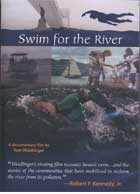
Swim for the River 2006
Distributed by Bullfrog Films, PO Box 149, Oley, PA 19547; 800-543-FROG (3764)
Produced by Tom Weidlinger
Directed by Tom Weidlinger
DVD, color, 56 min.(main feature); 50 min.(9 additional short films)
K-Adult
American Studies, Environmental Studies, Geography, History
Date Entered: 04/04/2007
Reviewed by Jeremy Linden, Head of Archives and Special Collections, Daniel A. Reed Library, State University of New York College at Fredonia, Fredonia, NYIn the summer of 2004, Christopher Swain became the first person to swim the length of the Hudson River from its source at Lake Tear of the Clouds in the Adirondacks to its outlet into the Atlantic Ocean. His stated goal was to work to protect the water, achieved not only through the swim itself but through the meetings held with concerned citizens as he progressed down the river. The result is a return of the Hudson and pollution to the public consciousness, and the giving of a voice to the people who live on its banks.
Filmed as a journey down the river, the “swim” itself was a means to raise public awareness, rather than achieve a physical goal. Little film time was spent on the equipment or preparation for the journey, and once begun the physical hardship of the swim was little discussed. The features are the stops, the obstacles encountered, concentrated on assessing the health of the river itself. North of Newcomb, NY, the entire width of the river is blocked by an old road bed for a closed mine – Swain swims through the only passage the water has, through one of four culverts, blocked and clogged by debris, dead fish, and stagnant water. Further downstream, he had to portage around five different hydroelectric dams over the course of his trip. At Glens Falls, he had to exit the river entirely– the water was channeled through pipes to drive the turbine of a paper plant. In order to regain access to the water, he traveled beyond where the plant has fenced in a stretch of water and waded back upstream, past the outlet pipes which released the effluent of paper-making process – chemicals, metals, and tons of solid waste – back into the river. Behind the fence, the effluent pipe is “out of sight, out of mind,” as Swain calls it.
The above are only two examples of what was documented along the way – deaths in Fort Edwards due to PCB poisoning, heated “bathtub” water released from the nuclear power plant at Indian Point, and oil leaking into Newtown Creek complete the sad portrait. Included are meetings with those individuals seeking to protect the river, from local citizens, to Pete Seeger and the Sloop Clearwater – an educational program to teach students about the health of the river – to the Riverkeepers, the non-profit organization dedicated to the protection of the river, primarily through legal means. The overall presentation is both shocking and hopeful, from the realization that pollution is still very real and dangerous, to the knowledge that there are people fighting it.
The film, a combination of footage of the swim and interviews and meetings with citizens and activists along the way, is
Short Films included on DVD: